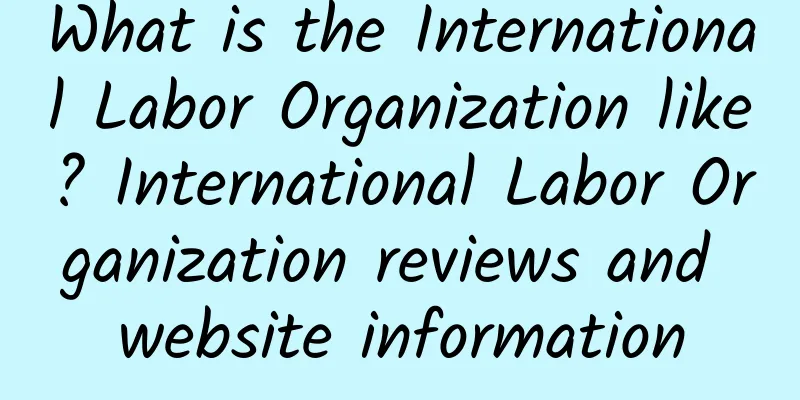What is the International Labor Organization like? International Labor Organization reviews and website information

|
What is the website of the International Labor Organization? The International Labor Organization (ILO) is a specialized agency of the United Nations that deals with labor affairs. It was established in accordance with the 1919 Treaty of Versailles and as a subsidiary of the League of Nations. Its headquarters is located in Geneva, Switzerland, and its training center is located in Turin, Italy. Its secretariat is called the International Labor Office. On December 14, 1946, ILO became a specialized agency of the United Nations; in 1969, it won the Nobel Peace Prize. Website: www.ilo.org/global/lang--en/index.htm The International Labour Organization (ILO) is a United Nations specialized agency dedicated to global labor affairs. As an important part of the United Nations system, the ILO's mission is to promote social justice, promote decent work, and improve working conditions and living standards for workers around the world. Its founding can be traced back to the Treaty of Versailles in 1919, when it was born as a subsidiary of the League of Nations. Over time, the ILO has gradually developed into a guardian and advocate of global labor rights. Historical background of the International Labour OrganizationThe origin of the International Labor Organization is closely related to the reconstruction of the international order after World War I. In 1919, with the signing of the Treaty of Versailles, the League of Nations was established, and the ILO came into being as its subsidiary organization. Its main purpose is to improve workers' working conditions, reduce social inequality, and promote global peace and stability by formulating international labor standards. On December 14, 1946, ILO officially became a specialized agency of the United Nations, marking the further enhancement of its status in global labor affairs. In 1969, ILO won the Nobel Peace Prize for its outstanding contribution to promoting social justice and labor rights. This honor is not only a recognition of ILO's work, but also highlights the importance of labor rights in global peace and development. Mission and objectives of the International Labour OrganizationThe core mission of the International Labor Organization is to promote social justice, promote decent work, and ensure that all people can work in conditions of freedom, fairness, safety and dignity. In order to achieve this goal, the ILO has established four strategic goals:
Structure and functioning of the International Labour OrganizationThe ILO has a unique operating model, which is a tripartite structure, where representatives of governments, employers and workers participate in decision-making. This structure ensures a balance of interests between all parties in policy formulation and implementation. The highest decision-making body of the ILO is the International Labour Conference, which is held annually in Geneva. During the conference, representatives of member states discuss global labor issues and adopt international labor standards. The conference is also responsible for electing members of the ILO's Board of Directors. The daily affairs of the ILO are handled by the International Labour Office, which is the secretariat of the ILO and is headquartered in Geneva, Switzerland. The main responsibilities of the International Labour Office are to implement the resolutions of the International Labour Conference, provide technical support to member states, and carry out research and training in the field of labor. In addition, the ILO has a training center in Turin, Italy, which provides training courses for labor professionals around the world to help them improve their skills and knowledge to better meet the challenges of labor issues. International labor standards and conventionsThe International Labor Organization provides a legal framework for global labor rights by formulating international labor standards. These standards are issued in the form of conventions and recommendations, covering all aspects of the labor field, including employment, working conditions, social security, occupational safety and health, etc. Conventions are the core of international labor standards and are legally binding. After ratifying a convention, member states must incorporate its contents into their national laws and submit regular reports on implementation to the ILO. Recommendations provide policy guidance to member states. Although they are not legally binding, they provide important references for countries to formulate labor policies. So far, the ILO has adopted more than 190 conventions and more than 200 recommendations. Among them, the eight core conventions are regarded as the cornerstone of labor rights, including the Freedom of Association and Protection of the Right to Organize Convention (No. 87), the Collective Bargaining Convention (No. 98), the Forced Labor Convention (No. 29 and No. 105), the Abolition of Child Labor Convention (No. 138 and No. 182), the Equal Remuneration Convention (No. 100) and the Discrimination (Employment and Occupation) Convention (No. 111). The ILO's global impactThe International Labor Organization plays an important role in global labor affairs. By formulating and implementing international labor standards, the ILO helps countries improve working conditions for workers and promotes social justice and economic development. For example, the ILO has made remarkable achievements in abolishing child labor, prohibiting forced labor, and promoting gender equality. In addition, the ILO has provided a lot of technical support to developing countries to help them establish and improve labor policies and social security systems. Through training, research and capacity building, the ILO has enhanced the ability of countries to deal with labor issues and promoted cooperation and development in the global labor field. The ILO also actively participates in discussions on global issues such as climate change, digital transformation and migrant labor issues. By combining these issues with labor rights, the ILO contributes to the realization of global sustainable development goals. The future prospects of the ILOWith the deepening of globalization, labor issues are becoming increasingly complex. Technological progress, climate change, economic inequality and other factors have brought new challenges to labor rights. In the face of these challenges, the International Labor Organization needs to continue to innovate and adjust its working methods to better deal with future labor issues. First, the ILO needs to strengthen research on new technologies, understand their impact on employment and work, and formulate corresponding policy recommendations. For example, the popularization of automation and artificial intelligence may lead to the disappearance of certain jobs. The ILO needs to help countries meet this challenge and promote skills training and employment transformation. Second, the ILO needs to continue to promote global cooperation, especially in the areas of migrant labor and climate change. By strengthening international cooperation, the ILO can help countries develop more fair and sustainable labor policies and ensure that all workers can work in safe and dignified conditions. Finally, the ILO needs to further promote social dialogue and promote cooperation between governments, employers and workers. Through tripartite dialogue, the ILO can help all parties find common solutions to labor issues and promote social harmony and stability. ConclusionAs the guardian of global labor rights, the International Labor Organization has made great contributions to improving workers' working conditions and living standards over the past century. By formulating international labor standards, providing technical support and promoting global cooperation, the ILO has played an irreplaceable role in global labor affairs. However, in the face of future challenges, the ILO still needs to continue to innovate and work hard. Only through continued efforts and cooperation can the ILO achieve its mission, promote social justice and decent work, and create a more equitable and sustainable future for global workers. For more information about the International Labour Organization, please visit its official website: www.ilo.org/global/lang--en/index.htm . |
<<: What is the Süddeutsche Zeitung like? Reviews and website information
>>: What is Asahi Kasei Corporation like? Reviews and website information of Asahi Kasei Corporation
Recommend
How to eat walnuts and what are the benefits of eating walnuts
Everyone will never forget the memory of eating w...
What are the benefits of eating seaweed? What are the effects and functions of eating seaweed?
Seaweed is the most common organism in the sea. T...
How is CA Computer? CA Computer reviews and website information
What is the website of CA Technologies? CA Technol...
The efficacy and function of bananas and the taboos of bananas
Plantain is a tropical plant with lush branches a...
How to grow eggplant on the balcony
How to grow eggplant on the balcony? I think many...
The nutritional value of chicken What are the benefits of eating chicken
Chicken is tender and delicious. Most people like...
How is the University of Arkansas? University of Arkansas reviews and website information
What is the website of the University of Arkansas?...
The efficacy and preparation steps of ginger fish porridge
I went to a porridge shop some time ago and saw t...
What is Drake Group like? Drake Group reviews and website information
What is the Delek Group website? Delek Group is a ...
How to make maitake mushrooms? How to eat maitake mushrooms?
Grifola frondosa is an edible fungus with extreme...
The benefits of drinking pear juice
Snow pear juice tastes sweet, cool and refreshing...
How is Shire? Shire reviews and website information
What is Shire? Shire is a well-known British pharm...
Production process of stuffed eggplant
I don’t know if you have ever eaten stuffed eggpl...
What is Harvey Mudd College like? Harvey Mudd College reviews and website information
What is the website of Harvey Mudd College? Harvey...
Lemony Cherry Tomato and Purple Cabbage Salad
Everyone knows that cherry tomatoes are delicious...



![[Chanel] How long is the shelf life of Chanel perfume](/upload/images/67cc7f6aa3f9f.webp)





